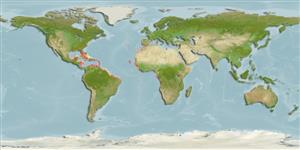Environment: milieu / climate zone / depth range / distribution range
Ecología
marino asociado a arrecife; rango de profundidad 0 - 5 m (Ref. 3723), usually 0 - 2 m (Ref. 40849). Subtropical; 43°N - 13°S
Western Atlantic: Massachusetts, USA and northern Gulf of Mexico to Brazil, including the Caribbean Sea (Ref. 3723); absent in Bermuda. Eastern Atlantic: Cape Verde and Dakar, Senegal to Luanda, Angola (Ref. 4497).
Length at first maturity / Tamaño / Peso / Age
Maturity: Lm 19.3 range ? - ? cm
Max length : 55.0 cm TL macho / no sexado; (Ref. 2683); common length : 35.0 cm TL macho / no sexado; (Ref. 3633); peso máximo publicado: 200.00 g (Ref. 5217)
Radios blandos dorsales (total) : 13 - 14; Radios blandos anales: 12 - 13. No ridge between nostril and eye (Ref. 26938).
An inshore, surface-dwelling species forming sizeable schools (Ref. 3723). Feeds mainly on sea grasses and small fishes (Ref. 3723). Mainly used as bait for offshore game fishes such as sailfishes and marlins; utilized as a food fish in the West Indies (Ref. 3723).
Life cycle and mating behavior
Madurez | Reproducción | Puesta | Huevos | Fecundidad | Larva
Robins, C.R. and G.C. Ray, 1986. A field guide to Atlantic coast fishes of North America. Houghton Mifflin Company, Boston, U.S.A. 354 p. (Ref. 7251)
IUCN Red List Status (Ref. 130435: Version 2024-2)
Threat to humans
Reports of ciguatera poisoning (Ref. 30911)
Human uses
Pesquerías: escaso valor comercial; carnada: usually
Herramientas
Special reports
Download XML
Fuentes de Internet
Estimates based on models
Preferred temperature (Ref.
123201): 20.5 - 28.1, mean 27.3 °C (based on 858 cells).
Phylogenetic diversity index (Ref.
82804): PD
50 = 0.5005 [Uniqueness, from 0.5 = low to 2.0 = high].
Bayesian length-weight: a=0.00380 (0.00277 - 0.00521), b=3.08 (3.02 - 3.14), in cm total length, based on LWR estimates for this species (Ref.
93245).
Nivel trófico (Ref.
69278): 2.3 ±0.1 se; based on diet studies.
Generation time: 1.9 ( na - na) years. Estimated as median ln(3)/K based on 2
growth studies.
Resiliencia (Ref.
120179): Medio, población duplicada en un tiempo mínimo de 1.4-4.4 años (K=0.58 questionable; assuming tmax>3).
Prior r = 0.46, 95% CL = 0.31 - 0.69, Based on 1 data-limited stock assessment.
Fishing Vulnerability (Ref.
59153): Low to moderate vulnerability (27 of 100).
Climate Vulnerability (Ref.
125649): High to very high vulnerability (75 of 100).
Nutrients (Ref.
124155): Calcium = 62.8 [19.5, 142.1] mg/100g; Iron = 0.681 [0.267, 1.717] mg/100g; Protein = 18.4 [15.6, 20.9] %; Omega3 = 0.136 [0.053, 0.389] g/100g; Selenium = 14.2 [5.6, 39.2] μg/100g; VitaminA = 31.6 [6.7, 165.2] μg/100g; Zinc = 0.985 [0.565, 1.712] mg/100g (wet weight);
